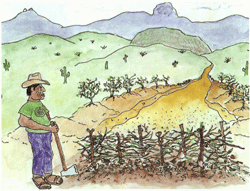Cultural Adaptations to the Desert's Bounty
by Gary Paul Nabhan, Director of Conservation Biology
from sonorensis, Volume 17, Number 1 (Spring 1997)
An O'odham farmer leaves his home on a low mesa before dawn, with a gourd full of water slung over his shoulder and an ax in his hand. He is out in the dark, but follows a trail down toward his field, and beyond, onto a floodplain channel upstream from the field. It is early June, and he has begun work to ready his field for a mid-summer planting dependent on the arrival of the monsoonal storms.
 Stopping in the mesquite bosque a quarter mile upstream from his field, the farmer sets his gourd canteen aside, and gets ready to wield his ax. He cuts foot-long posts from the side branches of a mesquite, then shapes them into a fence-like brush weir which, when the rains begin, will divert floodwater out of the wash and into the ditch leading to his plantings. In this way, he will concentrate the runoff from a watershed of several square miles onto the porous soil of his ak-chin field of several acres. (The term ak-chin literally means "mouth of a wash" and refers to places where stormwaters naturally spread out because of changes in floodplain slope gradients; fields were historically placed just downstream of where floodwaters and their detritus were deposited.) As the force of the floods is further broken by the series of brush weirs he has strategically placed above his field, other flood-washed detritus drops out of the waters to enrich the soil. By the very place he located his field-augmented by the deceptively simple water control features he annually rebuilds-this native farmer has overcome the two most limiting factors to food production in the desert: water scarcity and low fertility.
Stopping in the mesquite bosque a quarter mile upstream from his field, the farmer sets his gourd canteen aside, and gets ready to wield his ax. He cuts foot-long posts from the side branches of a mesquite, then shapes them into a fence-like brush weir which, when the rains begin, will divert floodwater out of the wash and into the ditch leading to his plantings. In this way, he will concentrate the runoff from a watershed of several square miles onto the porous soil of his ak-chin field of several acres. (The term ak-chin literally means "mouth of a wash" and refers to places where stormwaters naturally spread out because of changes in floodplain slope gradients; fields were historically placed just downstream of where floodwaters and their detritus were deposited.) As the force of the floods is further broken by the series of brush weirs he has strategically placed above his field, other flood-washed detritus drops out of the waters to enrich the soil. By the very place he located his field-augmented by the deceptively simple water control features he annually rebuilds-this native farmer has overcome the two most limiting factors to food production in the desert: water scarcity and low fertility.
A month later, during the first all-night rain, the farmer keeps vigil in his field with a torch to ensure that his checkdams and borders are not eroded away. The next morning, he plants a dozen kinds of drought- and heat-hardy grain and vegetables, refusing to drink any water himself until the sowing is done, for this would show the seeds that he knew they would suffer with drought no matter how he tries to help them. Despite a late season drought, he harvests several hundred pounds of beans, an equal amount of maize, as well as squashes, amaranths, devil's claw for basketry and cotton for textiles.
Instead of relying on sophisticated industrial technologies, this desert farmer drew upon his culture's knowledge of the desert to buffer his family from the vagaries of drought. Anthropologist Bill Lipe considers such indigenous scientific know-how the finest adaptation of desert farming cultures in the prehistoric Southwest. It's a technology of local knowledge-where the water is most likely to collect, where the mesquite grows the fastest, where the soil is deep and where an early frost won't kill off the crops.
The same holds true of village site location. Homes were often constructed on clayey mesas above the reach of floods, where good materials for adobe-making were abundant. The roof of an historic O'odham house was made of multiple layers of mesquite, saguaro ribs, ocotillo or arrowweed, and dirt tossed atop it all; the insulation properties helped to keep the homes cooler in the summer and retain heat in the winter. Oftentimes, floor level was six inches to a foot and a half deeper than the ground level outside, providing additional insulation.
Among the O'odham (River Pima, Desert Papago, Sand Papago and Lowland Pima), perhaps their gastronomic metabolism has been the most remarkable adaptation to the desert's bounty. When on a diet dominated by desert legumes, cactus pads, buds and fruit, chia and tansy mustard seeds, and baked agave hearts, the O'odham peoples suffered no diabetes, gall bladder or kidney disease. Their metabolisms had adapted to the prevailing plants seasonally available in the desert as foodstuffs, and those foods are much higher in moisture-retaining soluble fiber than conventional foods.
Today, most Native Americans have abandoned their traditional diet, and are extremely vulnerable to the "diseases of Western civilization," including diabetes and kidney, gall bladder and heart disease. By the year 2000, 250,000 Hispanic- and Native Americans in the desert Southwest will suffer from adult-onset diabetes, a disease largely preventable by maintaining traditional desert foods in the diet. It is therefore no longer possible to simply view historic adaptations to the desert as "quaint but obsolete"; the very genes and cells of indigenous desert dwellers carry with them the memory of landscapes and subsistence patterns of their ancestors.










